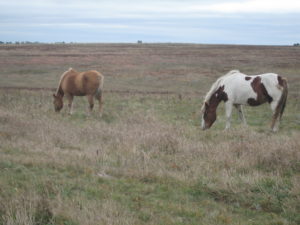Laminitis Risk in the Fall

Colder temperatures cause fructan content in grass to elevate and increase the risk of laminitis and founder for some horses.
Fall is upon us and temperatures are beginning to drop. This brings with it the risk of laminitis and founder for horse owners. Laminitis can be devastating for horses and donkeys alike as it means a deterioration of the sensitive laminae that bond the bone to the hoof. Hooves are designed to bear the weight of the animal so when the bone is detached from the hoof wall it can be extremely painful.
Prevention is the best cure for this disease so it is a good idea for owners to be aware of the feed that their horses may be eating. Most people think of spring and summer as the problematic time for horses to graze in pastures because grass is so lush. Fructan levels are highest in the spring, drop in the summer and then spike again in the early fall.
Grass in the early spring and fall is high in fructan content. Fructans are produced by photosynthesis in grasses to store sugar. Horses need less than 13 percent fructans or carbohydrates. Grass in the early spring usually consists of 30 percent fructan and can be as high as 40 percent. These levels go up again in the fall because of the colder temperatures.
Not all pasture grass is the same. Cool season grasses are especially high in fructan content. These grasses include orchard, timothy, brome, crested wheat and blue grass. Usually it is better to leave horses off this kind of pasture (or limit grazing time) in the early spring and fall. As temperatures rise in the summer, the level of fructan content goes down and it is safer for horses to stay out on pasture at this time. Some feeds such as fescue or rye grass should not be fed at all to horses because the fructan content is extremely high even in the summer. Warm season grasses such as Bermuda, Johnson and native prairie grasses have lower levels of fructan content. They are safer for horses but they should still be introduced to the pasture a little bit at a time, especially after eating hay all winter.
Fructan levels in grass can also fluctuate due to external stresses to the pasture. Cold, drought, grazing and sunlight all contribute to fructan levels. Sunlight stimulates fructan production so grasses are highest in fructan content in the early spring on warm days after it has been cold. Levels are high in the late afternoon and low in the early morning. This is why some horse owners let their horses graze in the evenings or overnight and then dry lot them during the day. Hay that has been cut early in the growing season is higher in fructans while second cutting hay or hay cut later will be lower.
If a horse has had too much lush grass and had an attack of laminitis, it is not the end of the world. Catching it at its early stages is best. Often, affected animals can be lame to due to abscesses forming in or around the sensitive laminae. Horse owners can remedy this by soaking the feet in warm water with Epsom salts to encourage the abscesses to break at the hairline instead of in the bottom of the foot (Add Epsom salts to warm water until it no longer dissolves). This can cause immediate relief for the animal. Removing the cause of laminitis (i.e. grazing on lush pasture) will do the most to help the animal recover.
In severe cases, a veterinarian and competent farrier should be called upon to help the horse. The veterinarian can take a complete blood count and prescribe drugs if necessary and the farrier can correctly apply therapeutic frog support shoes (heart-bar shoes) to alleviate the pain occuring in the front of the foot. In cases where shoe application isn’t possible, an injectable filler over the frog only, such as Vettec’s Sole Guard, is an acceptable alternative.
The owner may also choose to feed a supplement that stimulates new healthy hoof growth. This can be helpful in repairing the damaged laminae. Farrier’s Formula by Life Data Labs is a great supplement to use because it contains essential amino acids that are necessary to rebuilding a damaged hoof as well as liver protectants and thyroid-positive nutrients – all are necessary to help a recovering laminitic horse.
For more information, visit safergrass.org.
Related Posts
-
Punching a horseshoe nail hole that is clean so the nail fit...Sep 21, 2010 / 0 comments
-
©2013 Doug Butler PhD, CJF, FWCF Butler Professional Farri...May 14, 2013 / 0 comments
-
March is a special month for many reasons – from basketbal...Mar 02, 2010 / 0 comments
Blog Categories
- Anatomy
- Best Business Practices
- Conformation
- Current Events
- Customer Service
- Draft Horse Shoeing
- Equine Soundness
- Essential Anatomy Kit
- Farrier Careers
- Farrier training
- Foal soundness
- Horse Care
- Horse Foot Care
- Horse Owner Tips
- Horsemanship
- Horseshoeing
- Horseshoeing History
- Iron and Forge Work
- Student Spotlight
- Uncategorized
- Veterinary Care
Blog Archives
Contact Us
Butler Professional Horseshoeing School
495 Table Road
Crawford, NE 69339
(800) 728-3826
jacob@dougbutler.com
Subscribe to Our Blog
Get Our Free e-Book!
If you think you want to become a farrier (or know someone who does), this book can help you make that decision. Horse owners will learn the importance of choosing a qualified farrier and how to select the “right” one.
[ Get the e-Book Now! ]
- Follow:
